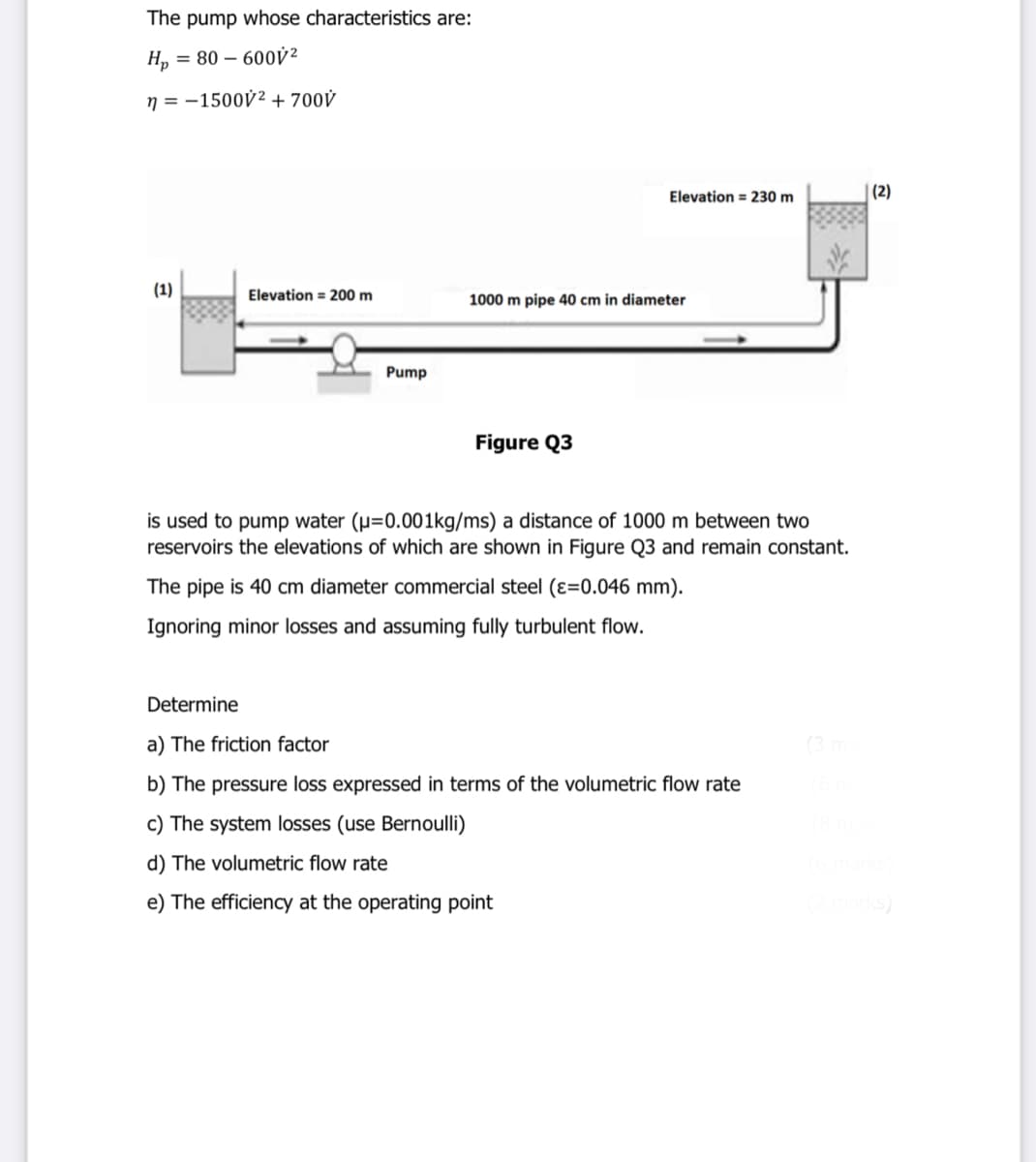The pump whose characteristics are: H, = 80 – 6o0v² n = -1500V² + 700V Elevation = 230 m |(2) (1) Elevation = 200 m 1000 m pipe 40 cm in diameter Pump Figure Q3 is used to pump water (p=0.001kg/ms) a distance of 1000 m between two reservoirs the elevations of which are shown in Figure Q3 and remain constant. The pipe is 40 cm diameter commercial steel (ɛ=0.046 mm). Ignoring minor losses and assuming fully turbulent flow. Determine a) The friction factor b) The pressure loss expressed in terms of the volumetric flow rate c) The system losses (use Bernoulli) d) The volumetric flow rate e) The efficiency at the operating point
The pump whose characteristics are: H, = 80 – 6o0v² n = -1500V² + 700V Elevation = 230 m |(2) (1) Elevation = 200 m 1000 m pipe 40 cm in diameter Pump Figure Q3 is used to pump water (p=0.001kg/ms) a distance of 1000 m between two reservoirs the elevations of which are shown in Figure Q3 and remain constant. The pipe is 40 cm diameter commercial steel (ɛ=0.046 mm). Ignoring minor losses and assuming fully turbulent flow. Determine a) The friction factor b) The pressure loss expressed in terms of the volumetric flow rate c) The system losses (use Bernoulli) d) The volumetric flow rate e) The efficiency at the operating point
Elements Of Electromagnetics
7th Edition
ISBN:9780190698614
Author:Sadiku, Matthew N. O.
Publisher:Sadiku, Matthew N. O.
ChapterMA: Math Assessment
Section: Chapter Questions
Problem 1.1MA
Related questions
Question

Transcribed Image Text:The pump whose characteristics are:
H, = 80 – 60ov²
n = -1500V² + 700V
Elevation = 230 m
| (2)
(1)
Elevation = 200 m
1000 m pipe 40 cm in diameter
Pump
Figure Q3
is used to pump water (µ=0.001kg/ms) a distance of 1000 m between two
reservoirs the elevations of which are shown in Figure Q3 and remain constant.
The pipe is 40 cm diameter commercial steel (ɛ=0.046 mm).
Ignoring minor losses and assuming fully turbulent flow.
Determine
a) The friction factor
b) The pressure loss expressed in terms of the volumetric flow rate
c) The system losses (use Bernoulli)
d) The volumetric flow rate
e) The efficiency at the operating point
Expert Solution
This question has been solved!
Explore an expertly crafted, step-by-step solution for a thorough understanding of key concepts.
Step by step
Solved in 6 steps with 6 images

Knowledge Booster
Learn more about
Need a deep-dive on the concept behind this application? Look no further. Learn more about this topic, mechanical-engineering and related others by exploring similar questions and additional content below.Recommended textbooks for you

Elements Of Electromagnetics
Mechanical Engineering
ISBN:
9780190698614
Author:
Sadiku, Matthew N. O.
Publisher:
Oxford University Press

Mechanics of Materials (10th Edition)
Mechanical Engineering
ISBN:
9780134319650
Author:
Russell C. Hibbeler
Publisher:
PEARSON

Thermodynamics: An Engineering Approach
Mechanical Engineering
ISBN:
9781259822674
Author:
Yunus A. Cengel Dr., Michael A. Boles
Publisher:
McGraw-Hill Education

Elements Of Electromagnetics
Mechanical Engineering
ISBN:
9780190698614
Author:
Sadiku, Matthew N. O.
Publisher:
Oxford University Press

Mechanics of Materials (10th Edition)
Mechanical Engineering
ISBN:
9780134319650
Author:
Russell C. Hibbeler
Publisher:
PEARSON

Thermodynamics: An Engineering Approach
Mechanical Engineering
ISBN:
9781259822674
Author:
Yunus A. Cengel Dr., Michael A. Boles
Publisher:
McGraw-Hill Education

Control Systems Engineering
Mechanical Engineering
ISBN:
9781118170519
Author:
Norman S. Nise
Publisher:
WILEY

Mechanics of Materials (MindTap Course List)
Mechanical Engineering
ISBN:
9781337093347
Author:
Barry J. Goodno, James M. Gere
Publisher:
Cengage Learning

Engineering Mechanics: Statics
Mechanical Engineering
ISBN:
9781118807330
Author:
James L. Meriam, L. G. Kraige, J. N. Bolton
Publisher:
WILEY